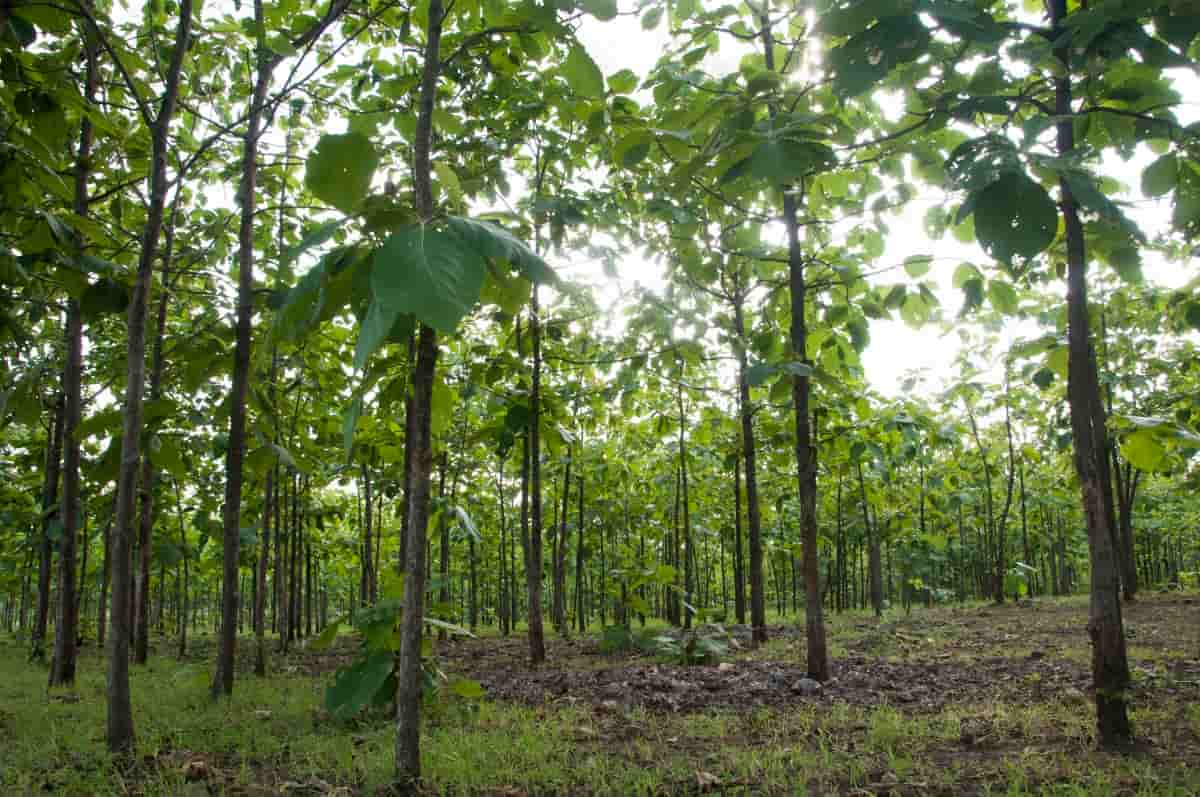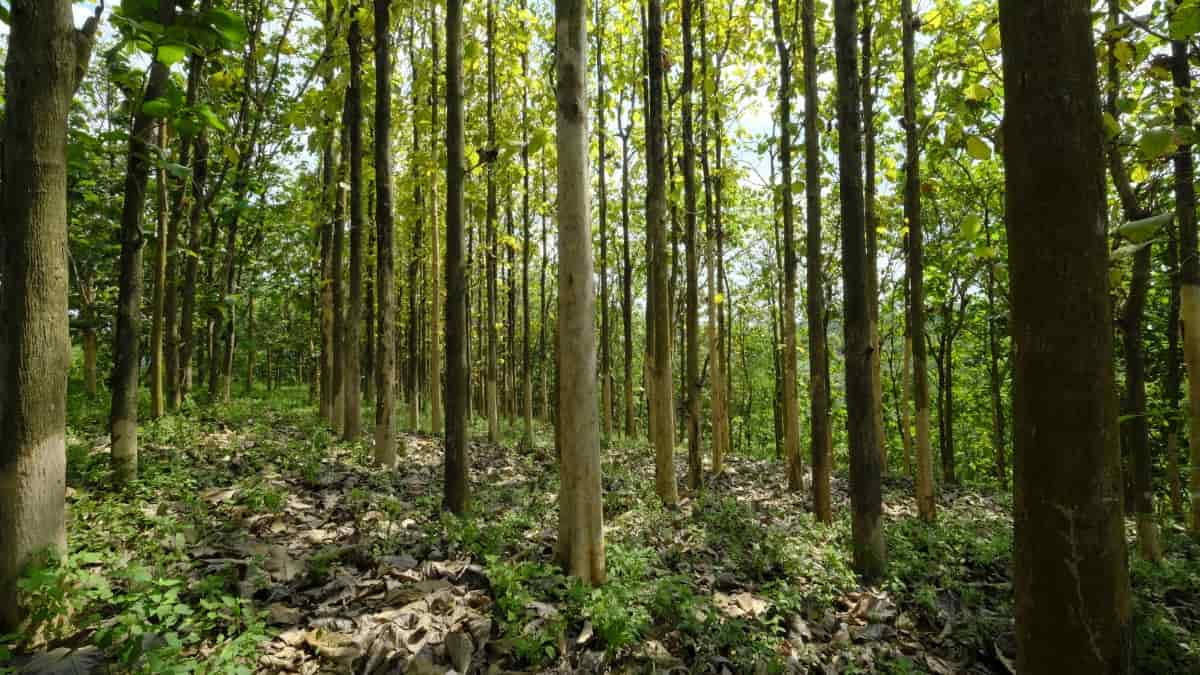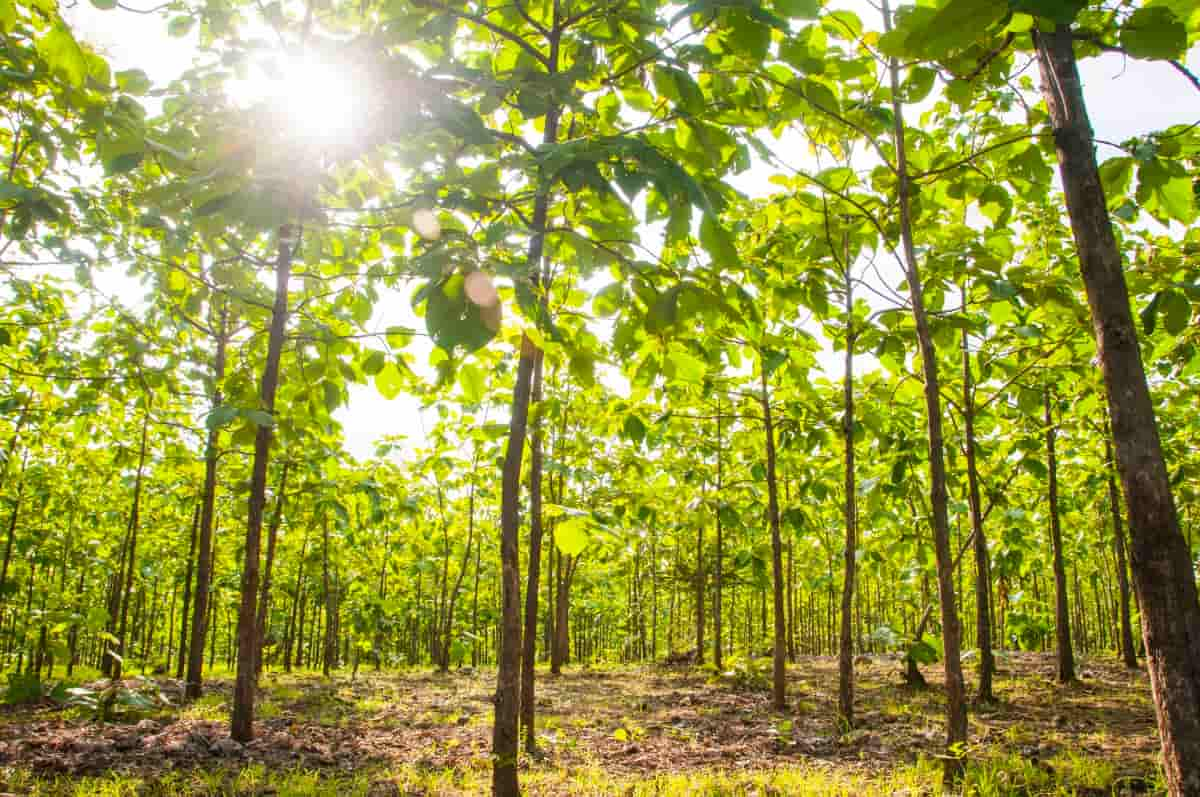Intercropping in teak plantations is a sustainable agricultural practice that enhances biodiversity and optimizes land use. Teak, a valuable hardwood, is often grown in large plantations, and introducing intercrops can increase profitability and ecological benefits. Among various combinations, teak and coconut intercropping has gained popularity due to their complementary nature.

Intercropping tuber crops with teak is another effective strategy, offering ground cover and utilizing different soil layers. This article explores various intercrops suitable for teak plantations, focusing on leguminous crops, fruit trees, medicinal and aromatic plants, grass and fodder crops, vegetables, spices and condiments, and oilseed crops.
Best Intercrops for Teak
Leguminous Crops as Intercrops for Teak Plantations
Leguminous crops are excellent intercrops for teak plantations due to their nitrogen-fixing ability, which enriches soil fertility. Pigeon pea, with its deep-rooting system, does not compete with teak for nutrients and provides additional income while the teak grows. Cowpea, a fast-growing legume, is ideal for covering the ground quickly, suppressing weeds, and improving soil structure.
Another beneficial leguminous crop is groundnut, which, being a low-growing plant, does not interfere with teak growth and adds economic value through its edible nuts. These crops enhance soil health, reduce erosion, and provide farmers with alternative income sources.
Fruit Trees Suitable for Intercropping with Teak
Fruit trees can be intercropped with teak to maximize land use and provide additional income. Banana, with its large leaves, provides shade and maintains moisture, which is beneficial for young teak plants. Papaya, being a short-duration crop, can be harvested before the teak trees grow large, making efficient use of space. Guava is another suitable choice; its deep-rooting system does not compete with teak roots, and it yields fruit quickly. These fruit trees not only diversify the plantation but also attract beneficial insects and birds, enhancing the plantation’s ecological balance.
Medicinal and Aromatic Plants as Intercrops in Teak Plantations
Incorporating medicinal and aromatic plants in teak plantations adds value through the production of high-value secondary crops. Lemongrass, known for its essential oils, can be grown between teak rows without hindering the growth of the main crop. Turmeric, a shade-loving herb, thrives under the partial shade provided by teak trees and improves soil health with its antimicrobial properties.
Aloe vera, with its minimal water requirement, is an ideal intercrop, providing additional income through its medicinal uses. These plants not only offer economic benefits but also contribute to the ecological health of the plantation.
Grass and Fodder Crops for Intercropping with Teak
Grass and fodder crops are beneficial intercrops in teak plantations, especially for farmers involved in animal husbandry. Napier grass, with its high yield and nutritional value, is an excellent fodder crop that can be grown between teak rows. Stylo grass, tolerant to various soil types, provides nutritious fodder without competing heavily with teak for nutrients.
In case you missed it: Cultivation Practices of Teakwood: Farming Steps and Number of Teakwood Plants Per Acre

Guinea grass, another robust option, grows quickly and offers substantial fodder production. These grasses help in soil conservation, prevent erosion, and can be a reliable source of fodder for livestock, thereby supporting integrated farming systems.
Vegetable Intercrops Compatible with Teak Plantations
Vegetable intercrops are suitable for teak plantations due to their short growth cycle and potential for quick returns. Tomatoes, with their shallow root system, can be easily grown between teak rows without competing for deep soil nutrients. Spinach, a fast-growing leafy vegetable, can be harvested multiple times before the teak canopy closes in.
Okra, another compatible vegetable, thrives in the same climatic conditions as teak and does not interfere with the primary crop. These vegetables not only provide additional income but also improve soil health through their diverse root systems and leaf litter.
Spices and Condiments Suitable for Intercropping with Teak
Spices and condiments are lucrative intercrops that can be grown with teak. Ginger, thriving in partial shade, is an ideal intercrop as it utilizes the under-canopy space effectively. Black pepper, a climber, can be trained on teak trees, using them as live supports, which optimizes vertical space.
Turmeric, already mentioned for its medicinal properties, is also valued as a spice and can be easily cultivated in the understory of teak plantations. These spices add significant value to the plantation and can be a source of high income due to their demand in both local and international markets.
Oilseed Crops as Intercrops in Teak Plantations
Oilseed crops can be intercropped in teak plantations to diversify income sources. Sesame, with its short stature and deep roots, does not compete with teak for sunlight and efficiently uses soil nutrients. Sunflower, another suitable oilseed crop, can be grown in the initial years of the teak plantation before the canopy closes in.
In case you missed it: 1-Acre Agarwood Tree Farming Project Report: Costs, Profit, and Production Economics

Castor, known for its tolerance to varying soil and climatic conditions, can be grown alongside teak without significant resource competition. These oilseed crops contribute to soil health, provide additional income through their oil-rich seeds, and can be integrated into various market chains.
Bamboo and Other Timber Species as Intercrops for Teak
Bamboo, with its rapid growth and versatile uses, is an excellent companion for teak, providing economic returns while the teak matures. Melia, a fast-growing timber species, complements teak in terms of growth patterns and wood value. Silver oak, often used as a shade tree in coffee plantations, can also be intercropped with teak, providing an additional timber source. These timber species not only diversify the economic output of the plantation but also ensure continuous canopy cover and habitat diversity.
Flowering Plants for Pollination and Biodiversity in Teak Plantations
Incorporating flowering plants like sunflower, marigold, and lavender in teak plantations enhances pollinator activity and biodiversity. Sunflower attracts bees and butterflies, which are essential for pollination, while marigold acts as a natural pest repellent with its strong scent. Lavender, known for its aromatic flowers, attracts a variety of beneficial insects, contributing to a balanced ecosystem. These flowering plants not only aid in maintaining ecological balance but also add aesthetic value to the plantation.
Cover Crops to Improve Soil Health in Teak Plantations
Cover crops like clover, vetch, and mustard are beneficial for soil health in teak plantations. Clover, a nitrogen-fixing plant, improves soil fertility, while vetch, with its dense growth, helps in weed control and soil moisture conservation. Mustard, known for its rapid growth, prevents soil erosion and can be used as green manure to enrich the soil.
In case you missed it: Frequently Asked Questions About Intercropping

Conclusion
Intercropping in teak plantations with a variety of crops such as legumes, fruit trees, medicinal plants, grasses, vegetables, spices, oilseeds, bamboo, timber species, flowering plants, and cover crops not only maximizes land use but also enhances biodiversity, soil health, and economic returns. This practice represents a sustainable and holistic approach to agroforestry, benefitting both the environment and the farmers. By adopting these intercropping strategies, teak plantation owners can ensure the long-term sustainability and profitability of their farms.
- Feed Your Flock for Less: Top 10 Tips to Save on Chicken Feed
- Ultimate Guide to Ossabaw Island Hog: Breeding, Raising, Diet, and Care
- Hatching Answers: The Top 10 Reasons Your Chickens Aren’t Laying Eggs
- Eggs and Economics: Breaking Down the Cost of Raising Backyard Chickens
- Defend Your Greens: Proven Methods to Keep Iguanas Out of Your Garden
- Ultimate Guide to Cinnamon Queen Chicken: A Comprehensive Guide for Beginners
- Ultimate Guide to California Tan Chicken: Breeding, Raising, Diet, Egg-Production and Care
- Ultimate Guide to Marsh Daisy Chicken: Breeding, Raising, Diet, and Care
- 10 Types of Chicken Farming Businesses You Can Start for Profits